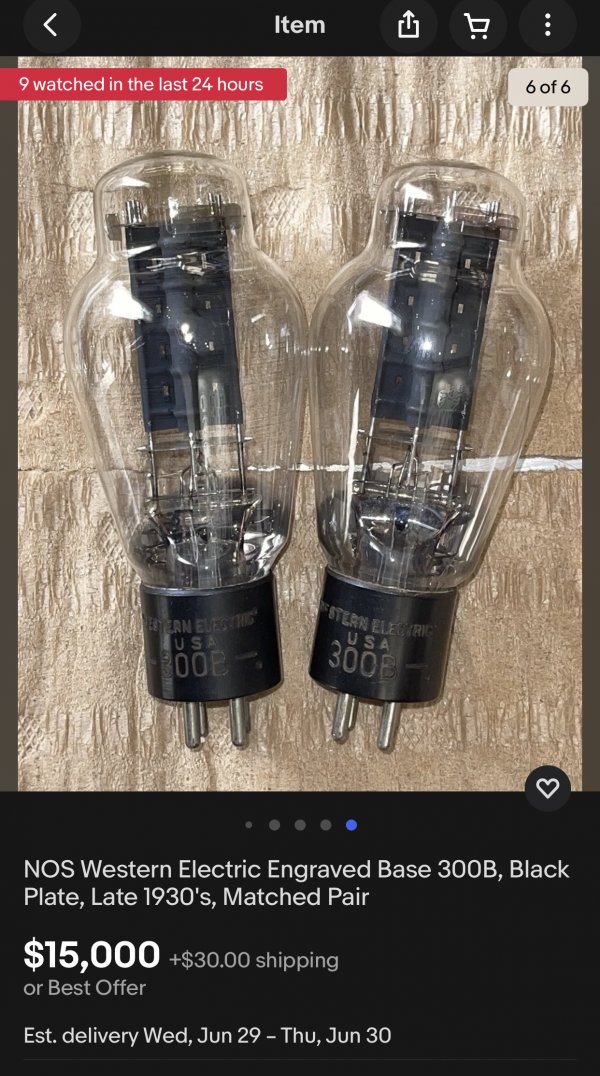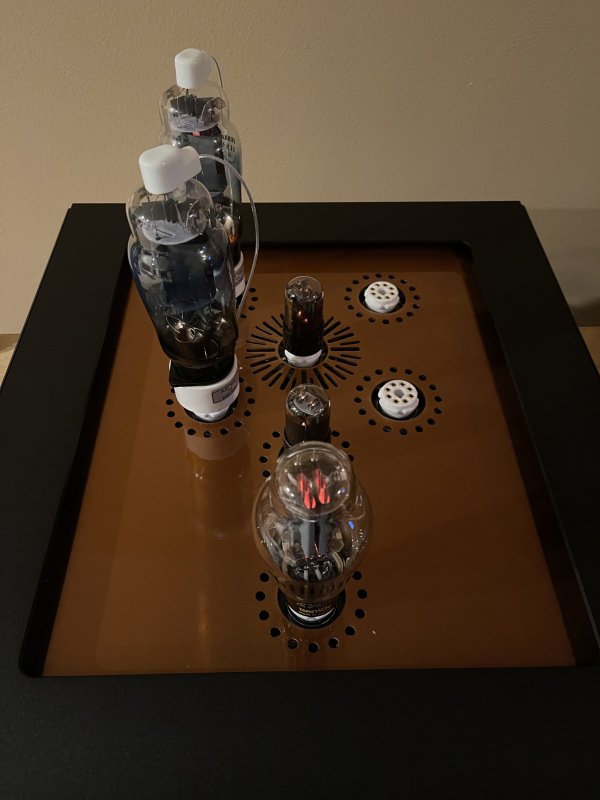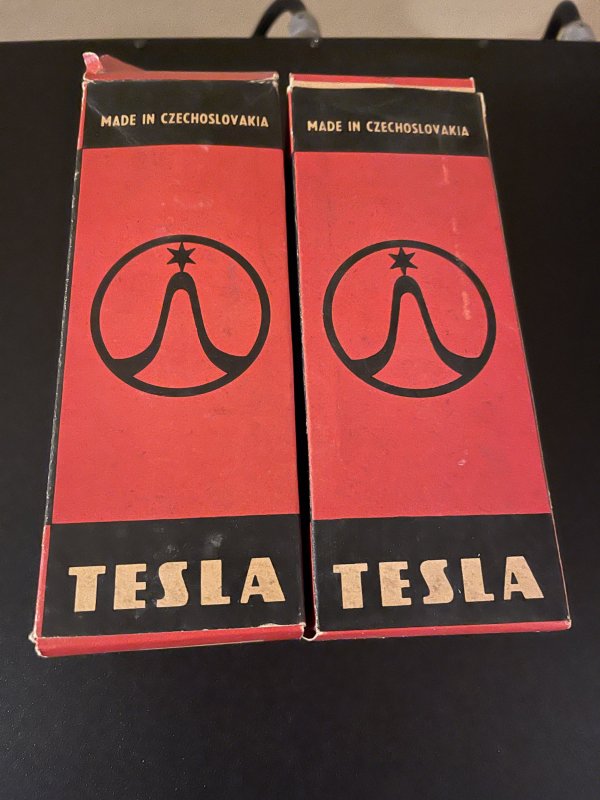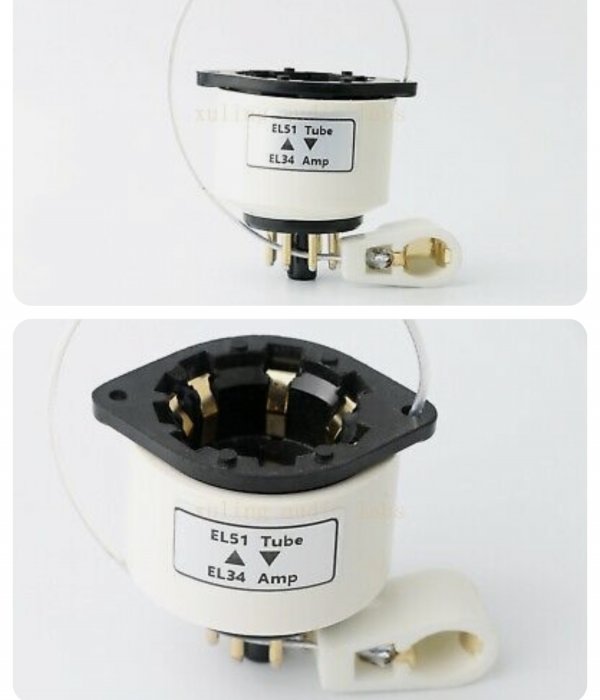Are you diligent about using the correct heater settings?Hmm.. keeping my score card of dead tubes handy, here’s the tally:
1. KR 242 (first set died, second set seems to be holding up so far).
2. KR T-100 (one tube died within a few hours of being fired).
3. PSVane 101D (new set, one died within a few hours)
4. VAIC 45 (two tubes died, two survived, seller took them back)
5. NOS 45 (two died, rest are doing ok so far)
It is not a pretty picture. If I didn’t like the Pacific so much, I’d have thrown in the towel. 300Bs are doing fine so far, PX 25s are also doing fine.
Lampizator announcement: launch of our all new TOTL HORIZON DAC
- Thread starter Lukasz "Lampizator" Fikus
- Start date
You are using an out of date browser. It may not display this or other websites correctly.
You should upgrade or use an alternative browser.
You should upgrade or use an alternative browser.
I put 16 WE 300B tubes in my amplifiers and paid $750 a tube. Maybe I should sell them.May the force be with you. My luck has not been so good. Speaking of having to buy expensive tubes for the Pacific, anyone feel like dishing out 15 grand for a pair of Western Electric 300Bs?
View attachment 94906
BYW, I have knock on wood, never had a problem with any tube in my Pacific.
No tube fails in my Pacific.
@godofwealth: Regarding the KR T-100 which I use but never compared with others, how did you like them and how would you compare them soundwise to other tubes?
@godofwealth: Regarding the KR T-100 which I use but never compared with others, how did you like them and how would you compare them soundwise to other tubes?
Something must be wrong there , I had my DHT tubes rolled in GG, then GG2 and PAC. Never ever lost a tube in any of them through last 6 years or so. All if them are testing like new even today. It is not normal, why you didn't sent it back for the factory check, Something must had happened in transport I believe, as it is impossible for the factory to let the tube killer dac out. No chance.Hmm.. keeping my score card of dead tubes handy, here’s the tally:
1. KR 242 (first set died, second set seems to be holding up so far).
2. KR T-100 (one tube died within a few hours of being fired).
3. PSVane 101D (new set, one died within a few hours)
4. VAIC 45 (two tubes died, two survived, seller took them back)
5. NOS 45 (two died, rest are doing ok so far)
It is not a pretty picture. If I didn’t like the Pacific so much, I’d have thrown in the towel. 300Bs are doing fine so far, PX 25s are also doing fine.
Actually the story of KT90 is a bit different and as per my Serbian sources they've not been made for Telefunken. Rather they have been developed and commissioned to be developed for Manley Labs at the beginning of 90's which had an exclusive rights for distribution and sales of this particular model...
Post from Eve Manley which I actually found in a thread here on WBF:
"I was there at the factory twice in in January 1990, mid 1991, and DM went a third time without me.
I was first in Nis the first week of January 1990 where they showed us the first prototypes of the KT90. There had been some correspondence between DM and the Ei factory for almost a year before our visit as to what he wanted them to build. (See my post above regarding the KT90 NOT being based on the EL519.)
The actual engineering of the guts of tube was done primarily by the head Ei engineer, Blagomir Bukumira. We took home four samples and did the initial testing. Some suggestions were made and production began. This was the first "red" paint version. As with any first production run, of which we had to buy ALL of them, there were things to be improved upon.
The second version incorporated some structural modification suggestions from Bill Perkins. This was the "blue" version. You can see the additional spot welds for the concentric inner anode structure if you compare them. More meat. As I have previously posted, in 1993, tubes that fell outside our acceptable parameters were sold to a certain tube vendor who put on a prettier brown base and silk-screened their own "KT99" logo onto the glass.
Then the war started and the embargo went up and none of us could get tubes out of there. The factory also was having trouble getting raw materials IN. Contrary to rumors at the time, the Ei factory was NOT bombed, as we now know.
There later came a third version with wings outside the anode structure but gone was the additional inner plate structure needing all those spot welds.
The latest KT90's I have here, what I would call the 4th version, the sacrificial element tacked onto the anode structure that was square is now circular. Other than that, it looks like the version 3 tubes to my eye.
Here are some quick pictures I just put up for you.
KT90's I have known and loved...
As for bad blood, there was some disappointment as we were supposed to be the world exclusive distributors for the KT90 but this part of the contract was not ultimately honored by the factory, although it was basically more or less enforced for two years. It was the "less" part of this equation that raised some concern. On the other side, it was understandable that other tube amp manufacturers were not happy to have to buy their tubes from a competitor in the tube amps biz who had been granted "exclusive rights for the whole world concerning advertising, sampling, and sale."
I have faxes from Ei-RC from March 1991 outlining all of this. It is quite interesting stuff.
With this, with the war, with all the weirdness that went down, perhaps the factory's memories fall short in some areas, but I was there and I have the original correspondence needed to refresh my memories.
Cheers, Eve Anna Manley, Manley Labs"
Post from Eve Manley which I actually found in a thread here on WBF:
"I was there at the factory twice in in January 1990, mid 1991, and DM went a third time without me.
I was first in Nis the first week of January 1990 where they showed us the first prototypes of the KT90. There had been some correspondence between DM and the Ei factory for almost a year before our visit as to what he wanted them to build. (See my post above regarding the KT90 NOT being based on the EL519.)
The actual engineering of the guts of tube was done primarily by the head Ei engineer, Blagomir Bukumira. We took home four samples and did the initial testing. Some suggestions were made and production began. This was the first "red" paint version. As with any first production run, of which we had to buy ALL of them, there were things to be improved upon.
The second version incorporated some structural modification suggestions from Bill Perkins. This was the "blue" version. You can see the additional spot welds for the concentric inner anode structure if you compare them. More meat. As I have previously posted, in 1993, tubes that fell outside our acceptable parameters were sold to a certain tube vendor who put on a prettier brown base and silk-screened their own "KT99" logo onto the glass.
Then the war started and the embargo went up and none of us could get tubes out of there. The factory also was having trouble getting raw materials IN. Contrary to rumors at the time, the Ei factory was NOT bombed, as we now know.
There later came a third version with wings outside the anode structure but gone was the additional inner plate structure needing all those spot welds.
The latest KT90's I have here, what I would call the 4th version, the sacrificial element tacked onto the anode structure that was square is now circular. Other than that, it looks like the version 3 tubes to my eye.
Here are some quick pictures I just put up for you.
KT90's I have known and loved...
As for bad blood, there was some disappointment as we were supposed to be the world exclusive distributors for the KT90 but this part of the contract was not ultimately honored by the factory, although it was basically more or less enforced for two years. It was the "less" part of this equation that raised some concern. On the other side, it was understandable that other tube amp manufacturers were not happy to have to buy their tubes from a competitor in the tube amps biz who had been granted "exclusive rights for the whole world concerning advertising, sampling, and sale."
I have faxes from Ei-RC from March 1991 outlining all of this. It is quite interesting stuff.
With this, with the war, with all the weirdness that went down, perhaps the factory's memories fall short in some areas, but I was there and I have the original correspondence needed to refresh my memories.
Cheers, Eve Anna Manley, Manley Labs"
Same hereI never once had a tube fail with my Pacific
I never once had a tube fail in any of my several (8!!
Did you get your dealer to look at the machine? Luksz is active on the forum hopefully he can helpHmm.. keeping my score card of dead tubes handy, here’s the tally:
1. KR 242 (first set died, second set seems to be holding up so far).
2. KR T-100 (one tube died within a few hours of being fired).
3. PSVane 101D (new set, one died within a few hours)
4. VAIC 45 (two tubes died, two survived, seller took them back)
5. NOS 45 (two died, rest are doing ok so far)
It is not a pretty picture. If I didn’t like the Pacific so much, I’d have thrown in the towel. 300Bs are doing fine so far, PX 25s are also doing fine.
Steve williams
Site Founder, Site Owner, Administrator
You’re obviously not OCD You're so luckySounding very promising
Waiting on other pairYou’re obviously not OCD You're so lucky
thanks. What is the converter?
Attachments
Yes. Trust me, I’ve checked and rechecked settings many times. Is it the Lampi, or just my bad luck in getting flaky tubes? Let’s not forget how unreliable tubes can be. I’m reminded that when John von Neumann, the brilliant Hungarian polymath who worked at the Institute of Advanced Study at Princeton with geniuses like Albert Einstein and Kurt Godel, he helped design the world’s first stored program digital computer (ENIAC) in 1945 using vacuum tubes! ENiAC was built at UPenn.Are you diligent about using the correct heater settings?
“By the end of its operation in 1956, ENIAC contained 18,000 vacuum tubes, 7,200 crystal diodes, 1,500 relays, 70,000 resistors, 10,000 capacitors, and approximately 5,000,000 hand-soldered joints. It weighed more than 30 short tons (27 t), was roughly 8 ft × 3 ft × 100 ft (2 m × 1 m × 30 m) in size, occupied 1,800 sq ft (170 m2) and consumed 150 kW of electricity. This power requirement led to the rumor that whenever the computer was switched on, lights in Philadelphia dimmed”
Hmmm… can you guess how large an iPhone would be if it was built with vacuum tubes? Let’s face it. We are using a 100+ year old obsolete technology. Amazed it’s still got some life in it after all these years.
I can sympathize, as I have gone through quite a number of DHT's and a rectifier in my Pacific. I think it mostly is the result of quality control issues at Kron, as they all were KR tubes. Lampizator acknowledged that the first run of RK 300B's had many life issues.Yes. Trust me, I’ve checked and rechecked settings many times. Is it the Lampi, or just my bad luck in getting flaky tubes? Let’s not forget how unreliable tubes can be. I’m reminded that when John von Neumann, the brilliant Hungarian polymath who worked at the Institute of Advanced Study at Princeton with geniuses like Albert Einstein and Kurt Godel, he helped design the world’s first stored program digital computer (ENIAC) in 1945 using vacuum tubes! ENiAC was built at UPenn.
“By the end of its operation in 1956, ENIAC contained 18,000 vacuum tubes, 7,200 crystal diodes, 1,500 relays, 70,000 resistors, 10,000 capacitors, and approximately 5,000,000 hand-soldered joints. It weighed more than 30 short tons (27 t), was roughly 8 ft × 3 ft × 100 ft (2 m × 1 m × 30 m) in size, occupied 1,800 sq ft (170 m2) and consumed 150 kW of electricity. This power requirement led to the rumor that whenever the computer was switched on, lights in Philadelphia dimmed”
Hmmm… can you guess how large an iPhone would be if it was built with vacuum tubes? Let’s face it. We are using a 100+ year old obsolete technology. Amazed it’s still got some life in it after all these years.
My first RK Anniv 5U4G was also clearly defective, but sneakily so, and it likely caused the demise of 3 of the 5 DHT failures I had due to it arcing sporadically - - something I found out by accident. I kept blowing fuses in my DAC during the phase where I lost 3 RK 300B's in a row over ~3 months from first getting my Pacific. Lukasz coached me in starting up the tubes softly at a point 3 clicks down, and then bringing them up to full after a few seconds as an attempt to help them live. It was once while doing this as I was looking down at the tubes from overhead to see how hot their filaments appeared that I saw a fireworks display go on in the RK 5U4G! After that rectifier was replaced (rectified!), I stopped losing DHT's so fast. But I still lost another RK 300B at ~800 hours or so, and an RK PX25 after ~30 hours. Common thread in all of this is Kron.
My T100's have been perfect, as have my KR 242's, so far.
Similar threads
- Sticky
- Replies
- 407
- Views
- 42K
- Sticky
- Replies
- 45
- Views
- 10K
- Replies
- 8
- Views
- 2K
- Sticky
- Replies
- 48
- Views
- 7K





